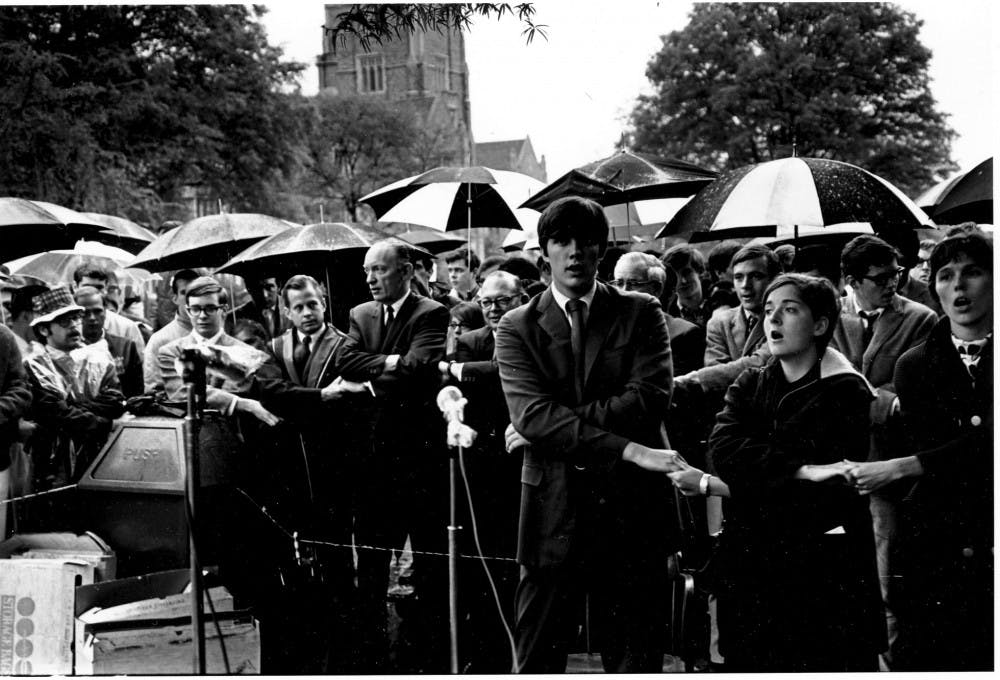The Allen Building Takeover was not a random demonstration, but rather the culmination of African American students’ protests at Duke in late 1960s.
Although the University underwent the process of desegregation in the early 1960s, the process of integration was much harder and took place over the entire decade. The rise in African American student activism in response to the University’s lack of integration efforts eventually led to the Allen Building Takeover of 1969.
Duke began the process of desegregation on March 8, 1961 when the Board of Trustees announced a new admissions policy that allowed students to be admitted without regard to race to Duke’s graduate and professional schools, as mentioned in Legacy, 1963-1993, a book published by the University to commemorate the 30th anniversary of Duke’s desegregation.
“Resolved that qualified applicants may be admitted to degree programs in the graduate and professional schools of the University, effective September 1, 1961, without regard to race, creed, or national origin,” the Board of Trustees resolution read, which was printed in a Chronicle article.
According to a Duke University Libraries exhibit on desegregation, the Divinity School and the Law School were the first graduate schools to admit African American students in September 1961.
Legacy explained that the Board announced that the undergraduate colleges would also be desegregated in June 1962.
The University welcomed its first African American undergraduates—Gene Kendall, Mary Mitchell Harris, Wilhelmina Reuben-Cooke, Cassandra Smith Rush and Nathaniel White, Jr.—in September 1963, Legacy stated. President Douglas M. Knight—whose tenure was characterized by bouts of student activism—arrived at Duke the same year.
Although the University was desegregated, African American students still had difficulties integrating into the Duke community.
At the height of the Civil Rights Movement, Dr. Martin Luther King, Jr. spoke at Duke in Page Auditorium on November 13, 1964. He discussed the progress of the movement, including the passage of the 1964 Civil Rights Act and the importance of integration.
“The idea that only time can bring about integration is false because time is a neutral quantity that can be used either constructively or destructively. The notion that legislation can’t solve the problem is only a half truth,” King said in The Chronicle article. “You can’t legislate integration, but you can legislate desegregation; you can’t change the heart, but you can restrain the heartless.”
As the 1960s continued, Duke saw incremental changes in the inclusion of African Americans on campus.
Samuel DuBois Cook, Trustee Emeritus and professor of political science, became Duke’s first African American faculty member in 1966. A year later, Harris, Reuben-Cooke and White were the first African American students to earn their bachelor's degrees in 1967, as noted by the library exhibit.
However, African American students were still excluded from many aspects of student social life. In particular, they were unable to attend off-campus events hosted by student organizations at segregated establishments like country clubs.

On November 13, 1967, African American students staged a day-long demonstration in the Allen Building, known as the Allen Building Study-In, to protest the use of segregated facilities by student organizations.
The Chronicle reported that the students sent a letter to President Knight demanding that he prohibit the use of segregated venues.
“The Duke University Afro-Americans DEMAND that our administration IMMEDIATELY announce and explicitly institute a policy of total prohibition of patronization of segregated facilities establishments by ANY University organization,” the letter stated, according to The Duke Chronicle.
Four days after the Study-In, a Duke Chronicle article described how Knight announced that the University was extending its existing policy prohibiting the use of segregated facilities to apply to all students groups.
The Study-In set the precedent for occupying the Allen Building, which was later repeated during the Allen Building Takeover.
After the Study-In of 1967, the next major student demonstration was the Silent Vigil, which was precipitated by the assassination of King on April 4, 1968.
Get The Chronicle straight to your inbox
Sign up for our weekly newsletter. Cancel at any time.

From April 5 to April 11, 1968, the University witnessed a student-organized demonstration that started with the nonviolent occupation of President Knight's house and eventually moved to Chapel Quad, according to the University Archives. The Duke Chronicle detailed that students kept a silent vigil on the quad for four days, culminating in a crowd of 1,400 people by the end.
Student activists also called for a boycott of the dining halls to support the food service and housekeeping employees who were on strike at the time. After the Vigil, the administration said they would raise the minimum wage for campus employees.
In addition to the Silent Vigil, 1968 marked the establishment of the Afro-American Society, the first African American student association at Duke, Legacy noted.
Representatives of the Afro-American Society met with faculty and administrators in October 1968 to discuss 12 “points of interest” regarding the status of African American students at Duke, The Chronicle reported. Their concerns included African American student enrollment levels, the need for an African American advisor and the membership of University officials at segregated country clubs.
“We’re working together to solve these problems,” said Chuck Hopkins, a member of the Afro-American Society, in the article.
However, the Afro-American Society would have to wait four months until President Knight responded to some of their demands, as mentioned in a Chronicle article from Feb. 4, 1969.
Legacy detailed how the African American community continued to try to make the administration address their concerns in early February during Black Culture Week—a scheduled week of speeches and programs led by local African American activists and writers on campus.
On Feb. 11, 1969, The Chronicle reported that approximately 75 African American students had visited President Knight’s home the previous night to give him a set of demands regarding the University’s treatment of African American students.
Two days later, members of the Afro-American Society began the Allen Building Takeover.

